The Wolves Survive, and Thrive
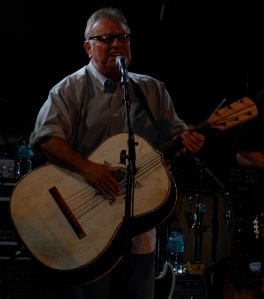
Conrad Lozano thumps his guitarrón
Los Lobos (acoustic) @ Belly Up, Aspen, Colorado 3/22/09
On Sunday night, the mighty Los Lobos pulled into Aspen for an ostensibly “acoustic” gig, playing material from their recent Acoustic en Vivo album, highlighting the group’s deep Latin roots. Together now for over 35 years, The Wolves have progressed brilliantly while always staying true to themselves, both as a recording group and a live act. Never content to just tread water, they have experimented with numerous sounds, textures, song structures and themes in the studio while taking cues from heavily improvisational groups like the Grateful Dead onstage.
Normally a sextet in concert, when the group hit the stage on Sunday it was a quartet, though true to its billing, an acoustic one.
Cesar Rosas cradled an acoustic guitar, Conrad Lozano thumped a guitarrón (an oversized, six-stringed acoustic version of his normal bass), Louie Pérez played a small guitar I think was a bajo sexto, and David Hidalgo fingered lightning fast arpeggios on an eight-stringed instrument I believe was a jarana. For the first few numbers, the multi-talented Steve Berlin lurked offstage.
From the outset, this quartet of players displayed one strain of its virtuosity on the unplugged numbers, playing, no doubt, with a rapidity, smoothness and dexterity that few indigenous Latin bands in the world can muster. The traditional Cuban composition “Guantanamera” became a rollicking sing along as the dance floor began to fill, and Lozano donned an ear-to-ear smile that would not dissipate over the course of the entire evening. The singing and playing during these acoustic songs was spot on, and though I was not familiar with several of the tunes, it didn’t matter because of the conviction and authenticity with which they were delivered.
About 25 minutes into the set, when it was time for Rosas’s “Chuco’s Cumbia,” a grooving dance tune from the group’s latest studio album, The Town and the City–complete with lyrics in Spanish and English, and one of several songs performed with Cumbia rhythms on this evening–a transformation began to occur.

A left-handed Strat plays the ultra-cool Cesar Rosas
Rosas picked up an electric guitar and the secret weapon of the band’s multi-layered sound, Berlin, appeared on stage with a flute. By several songs later, the whole band had plugged in and added a drummer. From here they never looked back, rocking an enthusiastic crowd of whirling dervishes for over 2 hours.
Highlights of the evening included a mesmerizing, scorching rendition of “Mas y Mas,” with Berlin playing some wickedly lowdown baritone sax, and an interesting arrangement of “Don’t Worry Baby,” on which the group’s ability to move from a scream to a whisper and back again was in full evidence.
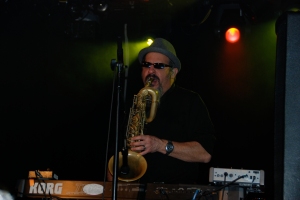
"Mas y Mas"
A spirited cover of “One Way Out” found Hidalgo imploring the crowd to sing along with the song’s chorus “might be your man/I don’t know,” but this Aspen crowd didn’t know the lyrics as well as the patrons of the Beacon Theater in New York , who were loving Hidalgo and Rosas when they joined the Allman Brothers onstage earlier this month for a version of the same song, amongst others.
Two other highlights of the evening were “Kiko” and “Saint Behind the Glass,” both songs from what is arguably the band’s magnum opus, 1985’s Kiko and the Lavender Moon. On the title track, Hidalgo picked up an accordion, showcasing yet another instrumental color on the collective palette of a group where EVERYONE, seemingly, can play anything, as long as it makes a sound.
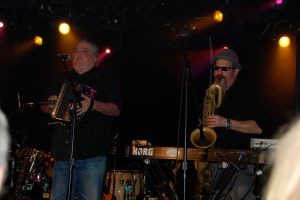
"Kiko and the Lavender Moon"
The aforementioned Grateful Dead were very much in evidence on Sunday, as The Wolves ran through versions of “Bertha” and another song often associated with that band, Buddy Holly’s “Not Fade Away.” They also covered “West L.A. Fadeaway,” a C+ calibre Dead song the group didn’t seem to know well, as Hidalgo confirmed at one point during an attempt to sing the third verse, “I don’t know the lyrics, man.” But it didn’t matter, as Los Lobos is so tight musically they made it sound right with Pérez, Rosas, and Hidalgo all firing off electrified guitar solos which underscored each man’s unique approach to the same instrument.
Rosas solos economically, playing with perhaps the most strait-ahead, rock & roll-style and attitude of the three axemen. Pérez takes the most musical chances, launching rapid clusters of jazz-inflected notes. He also has the most insistent, serrated tone of the trio. Hidalgo is somewhere in the middle, soloing with a nimble precision where every note seems to be part of an overarching architectural plan.
Great bands are predicated on great musicianship, and Los Lobos has it in spades. The Wolves’ musical simpatico is fueled by a virtuosic, multi-instrumental interplay and years of constant gigging, creating a group dynamic that is as indefatigable as it is magnetic. In a way, they’re one of the world’s greatest cover bands, though they’re much more because they play original and traditional material that’s as strong as any of the songs they cover. Nevertheless, whenever they roll into town, they bring a party-inducing sound that moves an audience’s feet and challenges its brains.
Synthesizing a dizzying variety of styles and roots influences–from Tex-Mex and traditional Latin music to rock, R & B, blues,country, jazz, rockabilly, and more– into its indelible array of songs, Los Lobos proved once again Sunday night why its music is so compelling. In short, if there’s a band in the world today mining more indispensable and interesting musical territory, I haven’t heard them.
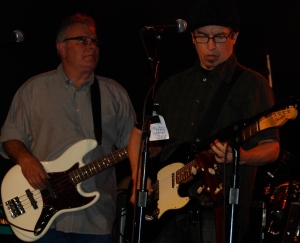
Conrad Lozano and Louis Pérez share a moment of intense musical dialogue
The return of Phish
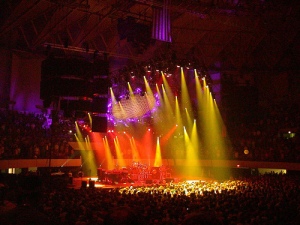
The Mothership Touches Down
No doubt, the long-anticipated Phish reunion shows in Hampton, Virginia earlier in the month were as musically important to the band as any shows they’ve ever played.
Personally, before the shows I was hoping the band would be hungry, breaking out the ultra-complex “Fluffhead,” and other classics–and playing them seamlessly–lest the guys in the group (and the fans) be unsatisfied with their performances.
Well, Phish answered the call, practicing tirelessly like they did in the old days, working hard to recall the ancient arrangements and jamming as incisively as they did two decades ago when I first started managing them from a small apartment in Boston.
In many ways, I think the mass popularity they’ve achieved is a double-edged sword for a band like Phish, whose fans know every word, every lick, every trick. As such, there’s nowhere to hide onstage because a minor mistake is always glaring.
Naturally, this is what makes a show by an improvisational group so compelling–the high wire act. In Hampton, Phish proved they are still wonderfully dynamic players and listeners, and for them, the whole is truly greater than the sum of the parts.
Of course, like Bob Dylan (and not too many others), one thing a concert-goer could never accuse Phish of is being staid, unlike the overwhelming majority of acts on the road today whose set list (and in some cases, even their stage patter) never deviates.
Talk about lame! And some fans choose to go on the road with these acts, seeing the same set list night after night, searching for variation.
But I digress.
I was impressed by Phish’s level of jamming, which seemed as preternatural as ever, even if some of the vocal harmonies were a tad suspect (of course, the band has never been, nor would I expect it to be–the Boys Choir of Harlem) and the songs, to some degree, have gotten less meaningful to me as I’ve gotten older.
In this regard–and it’s not a criticism, only an observation–I wonder how Trey will feel singing lyrics like “I saw you/with a ticket stub in your hand” when he’s 60?
That’s one reason I looked forward with anticipation to hearing the new songs, as I believe the only way to true sustainability as a band or an artist is to come up with new, compelling material, and to never rest on one’s laurels.
This is one thing Dylan, for instance, has always done with aplomb. The songs on his last three albums (and presumably his forthcoming album) are exceptional, and it has added an afterburner to a career that many thought was dead in 1975.
To do so, he mined the past; his past, the Anthology of American Folk Music, and the blues, those fertile gardens of inspiration from whence innumerable great songs have sprung.
Phish would also be well-served to mine that same territory. “Backwards Down the Number Line” is a new song which seems to attempt such a feat. It’s a nice, latter-day Phish song, with a simple chord progression and nostalgic lyrics that feel heartfelt and not as cloyingly clever as some of the older material. Yes folks, it’s FAR more difficult to be earnest (no pun intended, Trey) than it is to be clever, and earnestness (lyrically, not musically) is one thing Phish has always lacked in a certain way.
In my opinion, “Backwards…..” represents an important step in the right direction for the band, because the past is dead.
No, much to fans dismay, I’m sure, Trey will never write another song like “You Enjoy Myself” or “Divided Sky” or “Fluffhead” because he’s moved on.
These tunes are arguably his masterworks, but they were from a different time and place; a time when his overwhelming desire was to showcase how smart and ultra-compositional he could be–before he was a big star and had the weight of the responsible world on his shoulders, or, as Joni Mitchell succinctly put it, before he had to be “stoking the star making machinery behind the popular song.”
So, in short, it’s refreshing to hear a song like “Backwards….” because it represents a maturation both musical and personal, something any band or artist needs to keep evolving and avoid the kind of stagnation that invariably occurs when too much emphasis is placed on past successes, and not enough emphasis is placed on the present and future (for an example, see the Rolling Stones).
So way to go guys, I hope the other new songs are just as thoughtful and catchy. Trey has always had an unbelievable talent for playing his guitar and writing melodies, and I needn’t go into the musical acumen of Page, Mike and Fish, because if you’re reading this you already know how great they are, and how great they can be as a unit.
So good luck, Phish, I hope you guys find a way to keep it going for decades to come. The world needs you as much now as it needed you decades ago.
And speaking of decades ago, I wanted to share something I’ve never shared before–a bit of video footage I shot in 1990 with a single camera in Colorado. This is one of a handful of live video tapes I shot way back when, some of which hopefully will see the light of day someday, some way.
This is “David Bowie,” recorded live on 11/2/90 at Glenn Miller Ballroom, University of Colorado, Boulder.
I hope you enjoy this. You’ll note my camera style is a little herky-jerky in terms of the focal length, but back then I always tried to sync my camera movements with the music.
As always, thanks for lending me your eyes.
BRH
A Thousand Kisses Deep
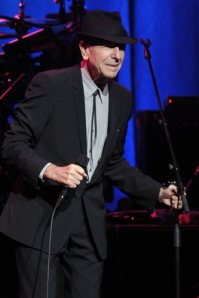
The Whole Damn Place Goes Crazy Twice
Leonard Cohen@The Beacon Theater, New York City- February 19, 2009
Last night, several thousand music fans in Manhattan were treated to a rare performance by the incomparable Leonard Cohen, who, at 74, proved he’s still spry enough to skip around the stage like a man half his age.
From the moment he appeared until the last note of his stunning sixth encore, the septuagenerian bard–one of the greatest songwriters of our era–held the assembled throng at rapt attention with performances of some of his finest songs.
Showcasing the deft, understated musical virtuosity of his backing band (a sextet augmented by three backing vocalists), and his own humble-yet authoritative showmanship, Cohen’s two sets at the refurbished Beacon Theater produced more than a few goosebump-inducing moments, even for the most cynical and hardened concertgoer.
Opening with the aching, sensuous “Dance Me To the End of Love,” Cohen set the tone for the evening. Almost immediately he dropped to his knees (a maneuver he would repeat many times during the performance) to deliver seductive lyrics like “show me slowly/what I only/know the limits of” in a weathered voice that has aged beautifully, its slightly deepened rasp somehow reinforcing the pervasive melancholy that inhabits a preponderance of his songs (editorial note: for an incredible reading of “Dance Me to the End of Love,” check out the modern day Billie Holiday, Madeleine Peyroux, whose smoky version of the tune is on her 2004 album Careless Love).
Next up was “The Future,” in which Cohen has apparently changed one powerful word, thus altering the impact of the song’s best couplet. In its recorded version, which appears on the early 90’s album of the same name, he sings “Give me crack/anal sex/take the only tree that’s left/stuff it up the hole/in your culture.” Last night he changed “anal” to “careless,” attenuating slightly the lyrical oomph of the tune, but perhaps few noticed. Who knows, maybe his recent, five-year Monastic retreat has mellowed Cohen’s mind.
In any event, highlights of the evening were many. One memorable second-set tune was “Hallelujah,” a song made most famous by Jeff Buckley, but also covered by many others, including Rufus Wainwright and John Cale. In his own rendition last night, Cohen appeared to be reading the lyrics from a small teleprompter leaning against one of his on-stage monitors, but this was more of a trifle than a major complaint.
And teleprompter be damned, during the song he improvised at least one (and maybe two) verses, a feat that might have impressed even the most hard-core hip-hop fan (though I doubt there were many in attendance). The overall effect was a magisterial one; an elder statesman at the top of his game, singing an anthemic composition that will live long after he’s left the earth.
Another high point was Cohen’s recitation of “A Thousand Kisses Deep,” a haunting tune from his 2001 album 10 New Songs, which last night he performed only as a poem. The song is one of his best, and it would have been nice to hear it with its musical accompaniment, though the words themselves were strong reminders of Cohen’s ability to feel deeply and put it down on paper.
One thing I did miss was Cohen’s regular recitation of a song’s lyrics before playing it, a method he plied to great success in 1993– the last time he stood on a stage in New York (for an equally amazing show at the theater at Madison Square Garden, the smallish room formerly called the Felt Forum in the 70’s)– when he toured behind The Future album.
Cohen’s band on this tour (sharply dressed–resembling white be-boppers–with 5 out of 6 wearing crisp suits, ties, and hats), chugging along like a quiet, propulsive engine, is a perfect foil for his gritty voice and doleful lyrics. Sounding like a crack Nashville session outfit accompanied by a gospel choir, and all the while swinging like a Spanish-tinged jazz combo, this sartorially splendid group features individually talented musicians who know first and foremost how to listen to each other.
The most bombastically virtuosic player in the group is Barcelona native Javier Mas. A stringed-instrument wizard whose passionately physical, rapid-fire soloing lends a Flamenco feel to the sound, Mas’s playing is underpinned by lightning- fast, concise right hand work and his choice of instruments, which include bandurria and laud. Given his terse style of picking and the rest of the band’s vaguely countrified sound, Mas could’ve been playing the mandolin and not been too far out of place.
Cohen’s very attractive backing vocalists (including the Webb Sisters, Hattie and Charley, and his oft-songwriting collaborator Sharon Robinson) are all precise singers with honeyed voices. As such, the trio creates a compelling musical and aesthetic counterpoint, smoothing out Cohen’s rough edges and adding a velvety, carnal element to the proceedings which already feel sultry, if only by virtue of Cohen’s evocative words.
Dino Soldo, on assorted wind instruments, is the band’s the only weak link, occasionally verging into cloying, quasi-smooth-jazz territory, a la–dare I say it– Kenny G. (though obviously not that bad, and I actually enjoyed his harmonica work on “Democracy”).
Cohen’s own performance–including innumerable removals of his hat, which he would routinely place over his heart and bow reverently while band members were soloing or when he was receiving applause–harkens back to a svelte, pre-rock era when sharply-dressed crooners like Sinatra roamed the earth and wowed audiences. In turn, each band member would reciprocate, bowing respectfully at their leader and providing clear visual evidence of the musical and personal quid pro quo that exists within the confines of any successful group.
And Speaking of Sinatra, it’s clear he can’t be mentioned in the same musical breath as Leonard Cohen, great as he was.
No, Sinatra was a lifestyle; a singer, a drinker, a ladies man, a tough guy.
Cohen is something entirely different. He’s a thinker who feels deeply, and still gets the ladies. He’s a bona fide songwriting genius and poet whose songs will live forever, even if he’s never been a major presence on the pop charts, or influenced a young man to beat someone up.
Still, he knows how to perform, and he even knows how to write a few tough-guy lyrics of his own.
For his second encore of the evening, Cohen performed a highly funky, vastly rearranged “First We Take Manhattan” which found the band vamping as loudly as it had all night. Of course, owing to the fact Cohen was taking Manhattan, the song enjoyed a particularly piquant aura.
Naturally, the capacity crowd loved it, roaring its approval with one standing ovation after another and dozens of amateur photographers rushing to the front of the stage to snap photos. No doubt, every person who saw the show felt lucky to be there, as countless folks had clamored for weeks to no avail for the hottest concert ticket in recent memory.
Cohen just announced he’ll be kicking off an American tour starting in the spring, and seeing his show could not be more of an event.
In short, see him.
Run, don’t walk.
THE BAND:
Leonard Cohen: vocals, guitar, compositions
with:
Roscoe Beck: electric and acoustic bass, musical director
Bob Metzger: electric guitar, pedal steel, vocals
Neil Larson: keyboards, accordion, Hammond B-3 organ
Javier Mas: bandurria, laud, archilaud, 12-string guitar
Rafael Gayol: drums, percussion
Dino Soldo: keyboards, saxophones, harmonica, assorted wind instruments, vocals
Sharon Robinson: vocals, compositions
The Webb Sisters–Hattie Webb: vocals, harp, and Charley Webb: vocals, guitar
SETLIST:
Dance Me to the End of Love
The Future
Ain’t No Cure for Love
Bird on a Wire
Everybody Knows
In My Secret Life
Who by Fire
Chelsea Hotel #2
Hey, That’s No Way To Say Goodbye
Sisters of Mercy
Anthem
INTERMISSION
Tower of Song
Suzanne
The Gypsy’s Wife
The Partisan
Boogie Street
Hallelujah
I’m Your Man
A Thousand Kisses Deep (recitation)
Take This Waltz
ENCORES:
So Long, Marianne
First We Take Manhattan
Famous Blue Raincoat
If It Be Your Will
Democracy
I Tried to Leave You
Whither Thou Goest
London Calling! Contemporary Art Strong……..
Much to the delight of artworld pundits, Contemporary Art has again defied prevailing economic conditions, as evidenced by Sotheby’s scaled-down Evening sale in London on February 5th.
Selling 25 of 27 lots for a grand total of nearly £17.9 million ($25.8 million), against a total pre-sale estimate of £16.5-23.1 million, the auction house proved that great art is still viable, with seven works selling for over a million U.S. dollars. Key lots included those by perennial favorites Andy Warhol, Jeff Koons and Anish Kapoor, while a very recent, large white “infinity net” painting by Japanese superstar Yayoi Kusama (one of my favorite artists) sold for an impressive total of £217,250, against a pre-sale estimate of £150,000-200,000.
Following hot on the heels of Sotheby’s and Christie’s Impressionist and Modern sales earlier this week in London, which garnered an astronomical grand total of £95,993,050, Sotheby’s contemporary sale at once again underscored the real value of art as a spiritual balm in times of economic uncertainty, not to mention a perceptual safe harbor for those who seek a higher form of intellectual return on capital than can be garnered by investing in other roiling markets.
The next major test of the contemporary market, Christie’s highly-anticipated evening sale, will take place on February 11th in London.
My guess is that it, too, will confound the expectations of naysayers.
Art Me Up
In rocky times, we all need solace. Here is mine.
“The purchase of contemporary art in periods of economic uncertainty represents a logical fulfillment of men’s deep need to preserve a sense of stability. In the absence of consistent monetary value, what could be more reassuring than to play for very different stakes–human intelligence and the destiny of a cultural production that is being created before our very eyes……..So that money becomes linked, not to some arbitrary standard like gold or the dollar……but to another human activity which implies a level of sensibility and high intelligence both functional and concrete.” –Pierre Restany Art Aktuell, January 15, 1975
The John Wesley/John Updike connection
With the passing of Pulitzer Prize winning author and essayist John Updike, one naturally begins to take stock of his body of work.
Clyde Haberman in “The New York Times” said Updike “defined ‘the true New Yorker’ as someone who came with a ‘secret belief that people living anywhere else had to be, in some sense, kidding.'”
In the same paper’s opinion section, Verlyn Klinkenborg wrote “no matter what Updike’s books accomplished, he was, above all, a maker of sentences, one of the very best. You can read him for his books, but it’s better to read him for his sentences, any one of which–anywhere–can rise up to startle you with its wry perfection.”
“Wry perfection” is another way to describe the art of long-time New York painter John Wesley, who, according to Ken Johnson on Friday, makes paintings that “are nearly impossible to look away from.”
And while many unenlightened folks may still think of a guy named John Wesley as the founder of Methodism, John Wesley the painter inspires his own religious fervor amongst his acolytes.
Of course, I may be accused of comparing apples and oranges, but Updike and Wesley actually do share a connection, at least a literary one.
In his most well-known (though not most acclaimed) novel, The Witches of Eastwick, Updike name-checks Wesley, and though the book was published in 1984 and Updike called Wesley “newish,” the fact he mentioned Wesley was unknown to me until recently.
The exact quote from the book is a bit of dialogue spoken by Van Horne, the character also known as the devil therein: “……and in the hall I’ve got some very subtly raunchy oils by a newish painter called John Wesley, no relation to the crazy Methodist, he does what looks like illustrations to children’s animal books until you realize what they’re showing. Squirrels fucking and stuff like that.”
Who knew Updike was so enlightened?
John Martyn, 1948-2009
The music world lost one of its great unsung figures yesterday at the tender age of 60, British guitarist and songwriter John Martyn.
Martyn, a pioneer of the blues-inflected “jazz folk” sound, and an influence on the likes of Eric Clapton, Pink Floyd’s David Gilmore, and Phil Collins, to name just a few, had suffered with significant health and drinking problems for the past several decades, but remained active up until the end, performing with some regularity despite losing a leg to amputation in 2003.
Martyn was well-known amongst musical aficionados for his deft fingerpicking style and intensely soulful lyrics, but it was his voice, especially in latter years–an elegiac, hushed, gravelly instrument which seemed to speak the loudest.
His most resonant work will likely remain 1973’s “Solid Air,” an album considered by many to be one of the greatest British albums of the 70’s. The title cut of this LP, a tribute to Martyn’s fellow jazz-folkie Nick Drake, is a haunting tune which surely ranks with the most quietly intense, atmospheric compositions of all time.
From the same album also sprang “May You Never,” a bittersweet love song which was later made (semi) famous by Clapton (who, ever the mercenary, purloined his share of great songs from others and turned them into hits) on his 1977 album Slowhand (which also contained what is perhaps Clapton’s best-known song, “Cocaine,” also a cover, written by the indispensable Okie master J.J. Cale, but I digress).
Another album to seek out of Martyn’s is called The Church With One Bell. Released in 1998, it is wholly comprised of cover songs, including standards like “Strange Fruit” and “The Sky is Crying,” but also containing more contemporary gems by the likes of Ben Harper and Portishead.
Without belaboring the point, Martyn will be sorely missed by anyone who ever heard him sing and play and guitar with such alacrity, passion and honesty.
On a personal note, John Martyn will always have a special place in my heart, as I hired a guitarist to perform “May You Never” at my Mother’s memorial service in May, 2005. She had heard the song on a CD I had made for my son several years prior, and had fallen in love with it’s lyrics: “May you never lay your head down without a hand to hold/May you never make your bed out in the cold.”
After her passing, I found a note pad amongst her things on which she’d scrawled a few words she’d nicked from the chorus of “May You Never,” as if to remind herself of her life’s mission:
“Love is a lesson to learn in our time.”
Rest in peace, John Martyn, and thanks for making us feel. You will not be forgotten.
John Wesley “Question of Women” NYT Review
Happy New Year!
A glowing review of the John Wesley show appeared today in the New York Times, written by the venerable Ken Johnson.
Here it is, below.
In the meantime, you can see a video montage of the Wesley show from an earlier post at HunterCulture.com right here.
I will soon be adding much New Year’s prognostication and Old Year’s reflection. Please stay tuned…….
John Wesley
Question of Women
Fredericks & Freiser
536 West 24th Street, Chelsea
Through Feb. 7
For more than five decades John Wesley has been creating poetically resonant paintings in a formally acute cartoon style. Most of the paintings in this lovely show date from the mid-1990s and depict young women who look like fashion models. There is much exposed flesh and in several cases hints of Sapphic intimacy, but carnality is quickened by something more subtle, a preoccupation with the erotic intercourse of speech.
“The Liar” is a closely cropped picture of two women’s faces. One in profile is saying something as the other gives her a suspicious, sidelong glance. In “Whisper” a woman speaks into the ear of another, who, naked, reclines with a beatific expression. One of the show’s oddest pictures is “Good Night,” a close-up of two sets of much enlarged, voluptuous lips, one above the other. They seem to hover between speaking and kissing. There emerges the sense of a privately shared language of the feminine, a language of implication, misdirection and ambiguity. You might say that the painter is listening for the oracular voices of his own inner female.
The beauty of Mr. Wesley’s paintings is as much in the abstraction as in the imagery. The reduced palette of pinks, coral reds, black and sky blue; the sensuous flux of curvy contour lines; and the perfect fitting of large shapes into the rectangle of the canvas — combine all that with the tantalizing imagery and you have paintings that are nearly impossible to look away from. KEN JOHNSON
AC 360〫

The Aaron Cohen Nonet, Live at Katz's 12/22/08
Last night was the 2nd night of Hannukah, and fittingly, a fascinating socio-cultural experiment of the Jewish kind occurred at Katz’s Deli–that immortal palace of pastrami–on the lower east side of Manhattan. The occasion was a meeting of nine people named Aaron Cohen, part of first-time film maker and entrepreneur Aaron Cohen’s foray into the world of people who share his name.
It was a strange and somehow exhilarating time, with a truly diverse group of Aarons, mostly recruited using Facebook (Aaron the filmmaker has 100 friends named Aaron Cohen on Facebook alone), showing up to see what would happen.
Expectations for the evening had ranged from complete paranoia (one Aaron admitted taking his credit card out of his wallet before coming in case he was mugged) to skepticism, but all the participants, doubtless, shared some sense of anticipation about meeting a number of namesakes.
There was a rapper Aaron, a Doctor Aaron, a writer Aaron, 2 Aarons who keep kosher, and nine Aarons who have a unique relationship with their mothers. There was a septuagenerian Aaron Cohen from Baghdad who lives in Manhattan but was too concerned about any number of things to show up.
Aaron Cohen the filmmaker ultimately wants to get 100 Aaron Cohens together in a room for a kind of Aaron Cohen “festival” which he will film for posterity, and hopefully for commercial release. The project is an ambitious one, but also one with great potential to be, by turns, hilarious, probing, and culturally significant.
Being at Katz’s last night and feeling the rather ephemeral, but definitely palpable vibe in the air while hanging out with only nine Aaron Cohens, one can only imagine the strange synergies that could occur if 100 Aaron Cohens were present.
Filmmaker Aaron Cohen, if he can tap into this difficult to categorize zeitgeist–nomenclature, family dynamics, the Jewish diaspora, and the sociological implications of these intersections–will have, at the very least, a very interesting movie indeed.
This Note’s For You? (if you can afford it)
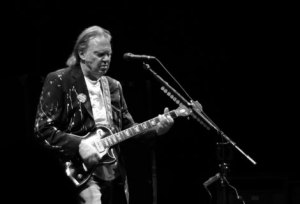
Hammering the Blues
Neil Young & His Electric Band
Madison Square Garden 12-16-2008
featuring:
Ben Keith (pedal steel, electric guitar, piano)
Rick Rosas (Bass)
Chad Cromwell (drums)
Anthony Crawford (electric guitar, backing vocals)
Pegi Young (backing vocals)
Don’t get me wrong. I love “Uncle Neil” (as one enthusiastic, 50-something fan in front of me kept calling him).
In fact, I’ve loved Neil since I was old enough to hear.
I’ve worn out copies of the three Buffalo Springfield records, the CSNY records, and Neil’s numerous solo efforts.
I love After the Gold Rush, Harvest, Harvest Moon, Freedom, Tonight’s the Night, Rust Never Sleeps, Ragged Glory, Comes a Time, Arc/Weld and too many others to mention in this short missive.
Hell, I even like 1981’s Re*ac*tor (on which, one song, “T-Bone,” is nine minutes of Neil singing “got mashed potatoes/ain’t got no T-bone” again and again and again).
And, for what it’s worth (no Buffalo Springfield pun intended), I’ve also seen Neil in concert many times, in both the U.S. and abroad.
On Tuesday night at MSG, the septuagenerian was in decent form (video here), rocking the rafters with songs that are decades old and, as usual, plying his trade on “Big Black”– Young’s omnipresent, 1953 Gibson Les Paul (and #1 weapon of choice in his prototypical, wrecking-ball sonic approach).
Interestingly, however, the rafters were not full at Madison Square Garden. No, the famed “blue seats” were 360 degrees vacant, perhaps owing to the ticket prices, which were 100 bucks apiece for the worst seats in the house.
It seems rather hypocritical, no?
I mean, seriously. Is Neil, a supposed “man of the people,” – full of self-righteous, rhyme-by-numbers new songs that glorify green cars, skewer the current administration’s greed and excoriate those who need to fix the financial mess by “coughing up the bucks”–really charging his loyal fans several hundreds of dollars for the best seats while delivering, at best, a middling-quality set of music?
Could it be Neil that’s actually beholden to the almighty buck as much as those he’s ripping in these sub-par new songs?
Look. Neil is one of the top 5 rockers of all time. He’s often a first-class topical songwriter who has never (to his credit) shied away from performing new material in concert, some of which he’s obviously composed on the fly.
But alas, at least for the moment, Neil may have run out of juice in his creativity cell, which is definitely not as “evergreen” as it once was.
No, the new songs he did Tuesday night about cruising in his alternative energy convertible–fossil fuels be damned–just don’t have the musical urgency or terse lyrical panache of, say, the one that goes (you’ll remember it) “Four dead in O-Hi-O,” or even (heaven help me for mentioning it in the same sentence) , “Let’s Roll.”
Neil himself seemed to recognize this fact, referring at one point to the new songs as “hidden tracks.”
I’ll go one step further, calling them “bowel-loosening tracks.” If memory serves, “You Don’t Need a Map” was a possible exception, with what I recall was an inspired lyric or two, but even that one, I suppose, I’m damning by faint praise.
Of course, there were some highlights in the set, notably the 1969 title track of his second solo album, “Everybody Knows this is Nowhere,” which Neil and his band handled with a rote efficiency typifying the evening; competent, occasionally inspired playing by professional musicians hired to seamlessly complement the craggy edges of Neil’s sound (in contrast to the roaring, 4/4 barroom stomp generated by his regular, on-again-off-again collaborators, Crazy Horse).
In this band, longtime collaborator Ben Keith is the star, adding beautiful texture and coloration to the music with spare, ever-tasteful pedal steel filagrees. As if to underscore the point, Young introduced the multi-instrumentalist by saying “this was a song I played with Ben Keith the first time we met,” before launching into (a rather perfunctory, I might add) “Heart of Gold.”
All in all, the songs from Rust Never Sleeps have aged very well. “Hey Hey, My My,” “Powderfinger” and “Cortez the Killer” were all delivered with a cold-blooded urgency, courtesy of Neil’s impassioned, squalling-yet-melodic guitar attack.
“Oh, Lonesome Me” was also a treat; a little played acoustic number which, along with “Unknown Legend” was the only highlight of the middle, acoustic part of the set.
The rest of the show felt rather like it was on auto-pilot, with Neil and company delivering the predictably-spiky musical goods and his loyal fans “coughing up the bucks” for pricey seats and Budweisers (oh, AND did I mention they have Bud Light?) for $9 apiece.
Well, at least the beer was cold.
Wilco, who opened for Neil, is a band that would’ve benefitted mightily from some amplitude, though openers are rarely afforded this luxury.
Musically anchored by the versatile guitarist Nels Cline, Wilco is a dynamic ensemble, though perhaps better suited to a smaller venue at this point.
Cline is a terrific performer who is full of twitches and gyrations, not to mention an array of world-class, effects-laden guitar pyrotechnics. His approach gives the band’s essentially pop sound (in the John Lennon, Beatles-esque mode) more depth and intrigue than is indicated by principle songwriter Jeff Tweedy’s muted, often unpredictable chord changes and limited melodic vocal approach.
Tweedy is an exceptional crafter of songs which don’t go for the easy hook, but instead insinuate their power through less obvious musical ideas that reward repeat listenings.
Highlights of Wilco’s set included “Handshake Drugs” and “Impossible Germany,” both of which demonstrated the finely wrought musical interplay of the sextet, and the punchy “Hate It Here,” a snippet of which can be seen and heard by following this link. Sorry about the shaky camerawork throughout, but it’s hard to hold that damn thing steady while zoomed all the way in.
More later.
Thanks for lending me your eyes.
Neil Young Set List:
Love and Only Love
Hey Hey, My My
Everybody Knows This Is Nowhere
Powderfinger
Spirit Road
Cortez The Killer
Cinnamon Girl
Oh, Lonesome Me
Mother Earth
The Needle And The Damage Done
Light A Candle
Cough Up The Bucks
Fuel Line
Hit The Road
You Don’t Need A Map
Unknown Legend
Heart Of Gold
Old Man
Get Back To The Country
Off The Road
When Worlds Collide
Just Singing A Song
Cowgirl In The Sand
Rockin’ In The Free World (w/ Wilco & Everest)
encores:
Get Behind The Wheel
A Day In The Life
Wilco Set List:
You Are My Face
I Am Trying To Break Your Heart
Handshake Drugs
A Shot In The Arm
Impossible Germany
Jesus, Etc.
The Late Greats
Hate It Here
Walken
I’m The Man Who Loves You